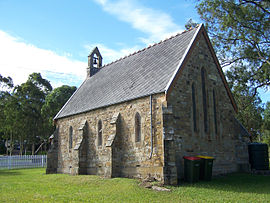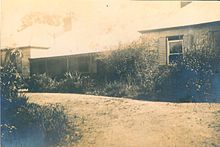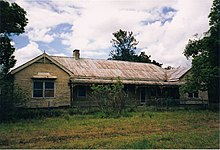Seaham, New South Wales: Difference between revisions
| Line 85: | Line 85: | ||
Since European settlement, there have been a number of reported bushfires in the Seaham district. |
Since European settlement, there have been a number of reported bushfires in the Seaham district. |
||
In June 1888 the relatively new Felspar House was almost destroyed by fires that burnt up to outbuildings<ref>http://trove.nla.gov.au/ndp/del/article/18957611?searchTerm=felspar%20fire</ref>. |
|||
On 18 February 1926 Seaham came under direct threat from serious bushfires that almost destroyed the Seaham School of Arts and the Seaham Hotel, (which stood on the corner of Vine and Dixon Streets between 1903 and 1935). |
On 18 February 1926 Seaham came under direct threat from serious bushfires that almost destroyed the Seaham School of Arts and the Seaham Hotel, (which stood on the corner of Vine and Dixon Streets between 1903 and 1935). |
||
Another bushfire threatened the Seaham district on 9 November 1928. ''The Canberra Times'' reported that the home of Mr. A. Burgess at "Brandon" was destroyed and that the landowners offered 5/- an hour for assistance in the fight against the bushfires at Seaham.<ref>{{cite web|url=http://newspapers.nla.gov.au/ndp/del/article/990250|title=Bushfires raging in many districts |publisher=[[The Canberra Times]]|date=10 November 1928|accessdate=27 August 2009}}</ref> |
Another bushfire threatened the Seaham district on 9 November 1928. ''The Canberra Times'' reported that the home of Mr. A. Burgess at "Brandon" was destroyed and that the landowners offered 5/- an hour for assistance in the fight against the bushfires at Seaham.<ref>{{cite web|url=http://newspapers.nla.gov.au/ndp/del/article/990250|title=Bushfires raging in many districts |publisher=[[The Canberra Times]]|date=10 November 1928|accessdate=27 August 2009}}</ref> |
||
Revision as of 02:25, 23 June 2010
This article needs additional citations for verification. (August 2009) |
| Seaham New South Wales | |||||||||||||||
|---|---|---|---|---|---|---|---|---|---|---|---|---|---|---|---|
 St. Andrew's Anglican Church, dedicated 1860. | |||||||||||||||
| Coordinates | 32°39′54″S 151°43′04″E / 32.66500°S 151.71778°E | ||||||||||||||
| Population | 372[2] (Seaham village only) Note1 | ||||||||||||||
| • Density | 8.052/km2 (20.85/sq mi) | ||||||||||||||
| Established | 1822 | ||||||||||||||
| Postcode(s) | 2324 | ||||||||||||||
| Area | 46.2 km2 (17.8 sq mi)Note2 | ||||||||||||||
| Time zone | AEST (UTC+10) | ||||||||||||||
| • Summer (DST) | AEDT (UTC+11) | ||||||||||||||
| Location |
| ||||||||||||||
| LGA(s) | Port Stephens Council[1] | ||||||||||||||
| Region | Hunter[1] | ||||||||||||||
| County | Durham[3] | ||||||||||||||
| Parish | Seaham[3] | ||||||||||||||
| State electorate(s) | Maitland[4] | ||||||||||||||
| Federal division(s) | Paterson[5] | ||||||||||||||
| |||||||||||||||
| |||||||||||||||

Seaham is a suburb of the Port Stephens Local Government Area in the Hunter Region of New South Wales, Australia.[1][6] It is located on the Williams River which flows into the Hunter River 14.6 kilometres (9.1 mi) downstream from Seaham village at Raymond Terrace.
It is a rural community supporting a small but expanding population. While the actual village of Seaham, which is located in the north-eastern corner of the suburb, is relatively compact and composed of only a handful of streets, the suburb itself covers an area of approximately 46.3 square kilometres (17.9 sq mi).[6] Greater Seaham covers an even larger area and incorporates East Seaham, Brandy Hill, Eagleton and Eskdale Estate.
History
Aboriginal settlement
Prior to the arrival of Europeans, the area now known as Seaham was home to the Garewagal clan of the Worimi people.[7]
Early British settlement
In 1822, Henry Dangar began surveying the Hunter Valley for settlement. Dangar divided the land into counties and parishes, reserving land for a township where the village of Seaham is now situated. The existence of a village at Seaham was proclaimed in the Government Gazette on 26 July 1838. In the ensuing years, the village became a crossroads between neighbouring centres such as Raymond Terrace and Maitland.
Military Station
Before the village of Seaham was proclaimed, a military station existed in the vicinity of what is now Wighton Street.
Growth of the village
During the nineteenth century, Seaham prospered as a river port, with the principal thoroughfare being North Crescent Street, next to the Williams River. Commercial activity moved to Warren Street during the twentieth-century after a succession of floods inundated the colonial riverside hub, (photographs indicate this may have been around 1913). By the 1920s, Seaham supported a hotel, post office, general store, three churches and a handful of other stores.
Prior to the establishment of the railway line between Maitland and Paterson in 1911, a line through Seaham was one of three alternative routes for the North Coast Railway. The proposed line would have connected Morpeth and Clarence Town, via Seaham. The surveyed line is visible on an 1887 map of Seaham, indicating a railway crossing over the Williams River between the township and Brandon House. At a public meeting in Clarence Town during October 1882 it was argued that the line through Seaham would present "more facilities and less engineering difficulties [than the proposed Maitland to Paterson route]".[8]
Porphyry vineyards
In 1838, Dr. Henry Carmichael established a vineyard at "Porphyry Point". In the ensuing decades the vineyard proved prosperous, winning numerous awards in Australia and Europe. The last vintage at Porphyry was in 1915, after which the name and trade mark was sold to Lindemans.[9]
Brandy Hill
Adjacent to Brandy Hill, a 180-metre (591 ft) high hill located approximately 4.7 km (2.9 mi) to the west of Seaham township is the Brandy Hill Quarry.[10][11] Travelling between the quarry and Raymond Terrace meant travelling a circuitous route through the Seaham township so Brandy Hill Drive was constructed to provide a shorter and more direct route. In the 1980s the land around Brandy Hill Drive was subdivided and the estate was named "Brandy Hill". On 7 April 2000 the subdivision was formally approved as a locality and became a suburb in its own right.[12] The suburb is almost surrounded by Seaham, while the hill itself remains within the suburb.[11]
Bushfires
Since European settlement, there have been a number of reported bushfires in the Seaham district.
In June 1888 the relatively new Felspar House was almost destroyed by fires that burnt up to outbuildings[13]. On 18 February 1926 Seaham came under direct threat from serious bushfires that almost destroyed the Seaham School of Arts and the Seaham Hotel, (which stood on the corner of Vine and Dixon Streets between 1903 and 1935). Another bushfire threatened the Seaham district on 9 November 1928. The Canberra Times reported that the home of Mr. A. Burgess at "Brandon" was destroyed and that the landowners offered 5/- an hour for assistance in the fight against the bushfires at Seaham.[14]

The most serious conflagration in Seaham occurred on 14 January 1939 (the weekend of the Black Friday bushfires in Victoria). The fire had been burning for two days in the heavy timber outside of the township, but residents were caught unaware by the suddenness in which the flames swept down onto the village. One of the first buildings to be engulfed by flames was the historic Felspar House on the outskirts of the town.[15]
Also lost was Porphyry House (circa 1840), the presbyterian church (circa 1878), the public school & schoolhouse as well as a number of other houses on Warren Street and at "Brandon".
In 1944, another bushfire swept down on Seaham and nearby Glen Oak. The fire was blocked on Clarence Town Road near the Glen Oak School of Arts. At Seaham, the fire was reported to have jumped the Williams River at "Felspar", the same estate where a house of historical importance was lost in the 1939 bushfires. The 1944 fires caused minimal damage in the Seaham district.
Historical timeline
The following is a timeline of significant events in the history of the town:
- 19th century (exact date unknown) - A row-boat carrying, in today's terms, thousands of dollars worth of cutlery and gold across the Williams River from East Seaham overturned in rough conditions, sending the contents to the bottom of the river. The gold and cutlery was never recovered.
- 1822 - Seaham is settled by Captain Paterson and land grants are made.
- 1830s - Walter Scott's house at "Eskdale" is built. As of 2009 it is still standing.
- 1838 - Seaham is proclaimed a town. Thriving rive trade boosts the population.
- 1839 - Work begins on Henry Carmichael's house at "Porphyry Point".
- 1844 - Robert Campbell is murdered by robbers while riding his horse on Clarence Town Road at Seaham, (he is thrown onto rocks in a creek and dies instantly). Campbell's bloody body is not found until the following day. The incident resulted in the creek being named "Deadman's Creek".
- 1850s - The White Horse Hotel opens on North Crescent Street. At the time, North Crescent Street is the main street, (post office, wharf, another hotel, ferry and general store are all within close proximity of the White Horse).
- 1852 - Seaham Public School begins operating in a wooden cottage by swamplands, (Middle Crescent Street).
- 1860 - The cornerstone of St. Andrews Anglican Church is laid. The church isn't consecrated until 1902.
- 1878 - First service is held at Seaham Presbyterian Church, (St. Saviour's,) on the corner of what is now Dixon and Still Streets. "Felspar" House is completed for Henry Carmichael's late son.
- 1882 - Work begins on William Fisher's "Brandon" House. It is completed two years later.
- 1885 - A brick classroom and teacher's residence are built on the current Seaham Public School site. Despite the improved conditions, classes are empty when school resumes in 1886, with most pupils grape cutting at the local vineyards.
- 1893 - St. Ita's Roman Catholic Church opens on Dixon Street, (near Presbyterian Church).
- 1902 - Seaham School of Arts opens on Warren Street.
- 1903 - Work begins on the Seaham Hotel.
- 1913 - Seaham is inundated by floodwaters.
- 1915 - Martha Sweeney dies when her home, opposite the Seaham Hotel, burns to the ground. The Porphyry Vineyards cease operations.
- 1917 - Six men from Seaham die in the Great War, (among them is the only living grandson of Henry Carmichael). In consequence, the "Porphyry" and "Felspar" estates are inherited by the Ralston and Graham families respectively.
- 1925 - Seaham Quarry is dedicated to "science for all time". The rocks are considered to be up to 120 million years old and are regarded as the best example of varve shale in the world.
- 1926 - Seaham is threatened by bushfires. The Seaham Hotel and School of Arts hall are almost destroyed.
- 1928 - Seaham is threatened by bushfires. The home of Mr. A. Burgess at "Brandon" is destroyed.
- 1935 - The abandoned Seaham Hotel burns to the ground.
- 1938 - Seaham Centenary celebrations, (similar events would be held at the 2002 celebrations).
- 1939 - Worst bushfires in Seaham since European settlement. Women and children evacuated by punt to East Seaham. The public school, presbyterian church and a number of historic homes are destroyed. Desperate efforts are made to save the School of Arts, post office and Catholic church. Depopulation of Seaham follows soon after.
- 1941 - The Presbyterian Church, destroyed in 1939, is rebuilt. Only casualty from the Second World War dies overseas.
- 1944 - Seaham and Glen Oak are threatened by bushfires.
- 1945 - Electricity is connected to Seaham.
- 1950s - Services cease at St. Ita's Roman Catholic Church on Dixon Street.

- 1955 - A new teacher's residence is built at Seaham Public School. Floodwaters inundate Crescent and Torrence Streets during the devastating 1955 Hunter Valley floods.
- 1964 - Services cease at the Seaham Presbyterian Church. The building is moved to Raymond Terrace.
- 1968 - A new classroom is built at Seaham Public School to replace the temporary schoolhouse used since the 1939 bushfires.
- 1973 - The Jim Scott Bridge is built, connecting Seaham and East Seaham. The Seaham Ferry makes a final river crossing.
- 1980s - Brandy Hill Estate is opened. Repopulation of Seaham begins.
- 2001 - Brandy Hill, with a population of almost 1,000, becomes a suburb in its own right.
- 2002 - "Seaham Celebrates"; a week of activities are held in recognition of 3 milestones in the town's history. It is also 180 years since settlement.
Places of significance
Cemetery
Seaham Cemetery, which is located on the outskirts of the Seaham township, has a traditional layout with headstones dating back to the 1850s. The cemetery is still in use and is maintained by Port Stephens Council.
Deadman's Creek
Between Seaham and Brandy Hill Quarry, the Clarence Town Road crosses a small watercourse named Deadman's Creek. The creek gained this sinister name after 1844 when a man from Clarence Town was found brutally murdered on the road, close to the modern-day crossing. Mr. Robert Campbell was found with his throat cut in such a way that his head was almost severed from his body. Closer inspection of the body revealed a gunshot wound on the deadman's jaw. Several hundred metres away, (in the Maitland direction), a large pool of blood was found. Police at the time took this as an indication that the deceased had been dumped near the creek after he was killed.[16]
Edgeworth David quarry
The Edgeworth David quarry is an historic quarry that was gazetted for preservation for scientific purposes in 1925.[17] It is named after the Australian geologist Edgeworth David, who discovered signs of late Palaeozoic glaciation in the Seaham area during 1914. The deposits at the quarry, identified as 'varve shale' in 1919, have been considered by geologists as the 'finest [example] in the world'.
The National Parks and Wildlife Service manage the site, which can be visited by everyone interested in geology and geological history of the Seaham area.
Historic properties

Only a handful of Seaham's historic homes are still standing. These include "Brandon" (established 1884), "Burnbrae", and "Eskdale". Brandon house still has thick, black tape over its internal windows. The tape was used during World War II to prevent the windows shattering in the case of an air raid. Other important homesteads included "Porphyry" (established 1838) and "Felspar" (circa 1878) - both of which were destroyed in the 1939 bushfire.
Seaham Swamp Nature Reserve
Seaham Swamp is recognised as an important habitat for the Cattle Egret and numerous other bird species. In addition to this, the reserve also protects a historic quarry, in which scientifically important sediments from ancient glacial thaw water have been found[18].
Gallery
-
St. Andrew's Anglican Church, dedicated 1860.
-
Presbyterian church, pictured in 1920. Destroyed by fire in 1939, rebuilt in 1941.
-
St. Ita's Roman Catholic Church, pictured 1938.
Notes
- ^ This population figure is only for the actual village of Seaham. ABS QuickStats for the rest of the suburb is included in the population data for Nelsons Plains and Duns Creek
as shown on 1:100000 map 9232 NEWCASTLE.
- ^ Area calculation is based on 1:100000 map 9232 NEWCASTLE.
References
- ^ a b c "Suburb Search - Local Council Boundaries - Hunter (HT) - Port Stephens". New South Wales Department of Local Government. Retrieved 2008-06-10.
- ^ Australian Bureau of Statistics (25 October 2007). "Seaham (L) (Urban Centre/Locality)". 2006 Census QuickStats. Retrieved 2008-06-10. Map
- ^ a b "Geographical Names Register Extract: Seaham". Geographical Names Register (GNR) of NSW. Geographical Names Board of New South Wales. Retrieved 2008-06-10.
- ^ "Maitland". New South Wales Electoral Commission. 24 March 2007. Retrieved 2008-06-10.
- ^ "Paterson". Australian Electoral Commission. 19 October 2007. Retrieved 2008-06-10.
- ^ a b "Seaham". Land and Property Management Authority - Spatial Information eXchange. New South Wales Land and Property Information. Retrieved 2008-06-10.
- ^ "The History of the Worimi People". Tobwabba Art. Retrieved 2008-12-25.
- ^ "Proposed Northern Coast Railway, Public Meeting at Clarence Town". The Maitland Mercury & Hunter River General Advertiser. Australian Newspapers. 7 October 1882. Retrieved 31 August 2009.
- ^ "The Wine Industry of Australia 1788 1979". Wine Talk. Retrieved 2008-12-25.
- ^ "Geographical Names Register Extract: Brandy Hill (hill)". Geographical Names Register (GNR) of NSW. Geographical Names Board of New South Wales. Retrieved 2009-02-10.; 1:100000 map 9232 NEWCASTLE
- ^ a b "Brandy Hill". Land and Property Management Authority - Spatial Information eXchange. New South Wales Land and Property Information. Retrieved 2009-02-10.
- ^ "Geographical Names Register Extract: Brandy Hill (locality)". Geographical Names Register (GNR) of NSW. Geographical Names Board of New South Wales. Retrieved 2009-02-10.
- ^ http://trove.nla.gov.au/ndp/del/article/18957611?searchTerm=felspar%20fire
- ^ "Bushfires raging in many districts". The Canberra Times. 10 November 1928. Retrieved 27 August 2009.
- ^ "186 Victims of Fire and Heat". The Canberra Times. 16 January 1939. Retrieved 27 August 2009.
- ^ "Wilful Murder". Maitland Mercury & Hunter River General Advertiser. Retrieved 31 August 2009.
- ^ Juanita McCarthy (December 2006). "Seaham Swamp Nature Reserve Draft Plan of Management" (PDF). Department of Environment and Conservation (NSW). Retrieved 2008-06-29.
{{cite web}}: Unknown parameter|coauthors=ignored (|author=suggested) (help); line feed character in|coauthors=at position 10 (help) (p.4) - ^ "Seaham Swamp Nature Reserve". NSW Government Department of Environment and Climate Change. Retrieved 2008-12-27.
- "Paterson (Tocal AWS)". Climate statistics for Australian locations. Bureau of Meteorology. Retrieved 2008-06-10.




